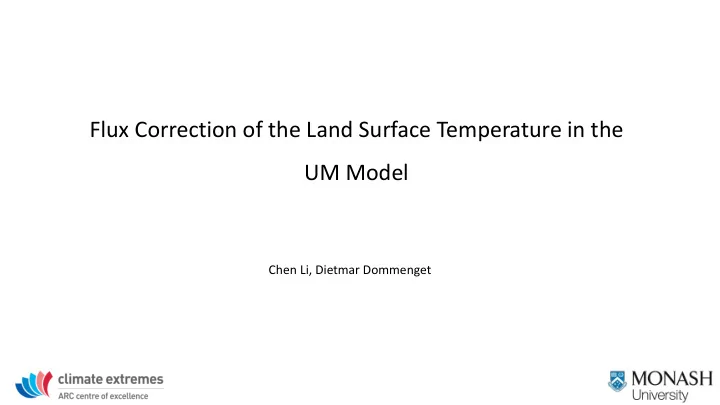

Flux Correction of the Land Surface Temperature in the UM Model Chen Li, Dietmar Dommenget
What is Flux Correction? Coupled with Fully coupled Uncoupled flux correction Pros: Fast, cheap and easy to apply; Mean state bias can be significant improved Adjust close to Provided by Climate observations observations drift Cons: may have unexpected effects on both mean state and variability. (Sausen et al. 1988)
Studies with flux-correction Uncorrected (Manganello et al. 2009) Flux-correction Uncorrected (Ding et al. 2015) Flux-correction
Importance of Land surface temperature Historical RCP8.5 - Historical (Dommenget 2016) (IPCC fifth assessment report) The Walker Circulation trends in AGCMs with identical SST forcing can be linked to differences in the land surface temperature (Yim et al. 2017)
AGCM simulations with prescribed land surface temperature Met Office Unified Model (UM 7.3): UM-fixed SST Horizontal grid spacing of 3.75 longitude by 2.5 latitude, 38 vertical levels (N48L38) Met Office surface Exchange Scheme (MOSES) Soil temperature Sensible and latent heat flux (UM original code) Net radiation Ground heat flux (Ackerley and Dommenget 2016) (3-hourly data) Is that possible to use a flux correction (Qflux) to adjust the surface temperature instead of holding it to a fixed value? % + 1 𝐵 𝑆 *+,%+ – 𝐼 − 𝜇𝐹 + 𝐷 3 𝑈 ∗ = 𝑈 ∆𝑢 𝑈 ∗678 − 𝑈 % + 𝑅𝑔𝑚𝑣𝑦
Estimate the Qflux through Iteration process Reference data: ERA-interim skin temperature (climatological 1979-2017) Qflux = ‘0’ Tsurf bias = simulated Tsurf – observed Tsurf Iteration 1 climatological monthly Qflux1 = Tsurf bias * HCF (heat capacity factor ~ 50W/m 2 /K) mean surface temperature (no Qflux) Tsurf bias = simulated Tsurf – observed Tsurf Iteration 2 (Qflux1) (adjust the HCF for each grid) Qflux2 = Qflux1 +Tsurf bias * HCF Iteration X Tsurf bias is general smaller than 0.5 K (Qflux X-1) Obtained the monthly mean heat flux correction scheme
Run length Climatology 5 years Last 3 years 10 years Last 5 years 20 years Last 10 years Annual mean surface temperature bias: Model - ERAint ITER2 (5yrs) ITER1 (5yrs) ITER3 (5yrs) ITER4 (10yrs) ITER5 (10yrs) ITER7 (20yrs) ITER8 (20yrs) ITER6 (10yrs) Two long-term runs: with/without heat flux correction Running 50years, analysis the last 30 years
Surface temperature mean state Annual mean surface temperature bias: Model - ERAint RMSD = 2.4 RMSD = 0.9 ‘JJA – DJF’ surface temperature bias
Surface temperature seasonal cycle ERAint No flux-correction flux-correction Month Month Month Month
Surface temperature daily cycle ERAint No flux-correction flux-correction Mean Daily cycle for January UTC time UTC time UTC time UTC time
Sea level pressure mean state Annual mean SLP bias: Model - ERAint RMSD = 1.9 RMSD = 1.7
UM-slab model: surface temperature bias Running 100 years, analysis the last 50 years as the climatology Annual mean surface temperature bias: Model - ERAint RMSD No flux Flux_land_ocean Flux_ocean All grid 1.8 0.7 (-61%) 1.4 (-22%) Land grid 2.6 0.9 (-65%) 2.4 (-7%)
Tsurf bias Precipitation bias Normalized UM-slab model: annual mean SLP and Precipitaion bias (K) (mm/day) SLP bias
Different atmosphere responses to the changed land surface temperature and sea surface temperature Discussion 1 Test1: added 100 W/m 2 heat flux in the East Pacific (EP) Test2: added 100 W/m 2 heat flux in the tropical Africa and South America (Africa_SA) Surface temp. 850hPa air temp. 1.5m air temp. 500hPa air temp. SLP Test 1 Test 2
Surface heat flux Total upward heat flux Upward sensible heat flux Upward latent heat flux Related to the different moisture conditions over the land/sea surface
Discussion 2 The importance of the daily surface temperature cycle to the annual mean SLP and precipitation 3hr -50 W/m 2 (first half day) Amazon region Input Change_daily_cycle +50 W/m 2 (second half day) (17.5S – 5N; 285 -310E) data Tsurf daily cycle (mean for January) Noflux EXP_daily_cycle (~1 ° C difference) Results based on 20-yrs average of a 30-yrs simulation
Discussion 2 Mean state difference related to the different daily cycle K mm/day Significance t level: 95%
Conclusions • The land surface temperature can be changed by including a flux-correction scheme in the UM model. • Correcting the land surface temperature can help to reduce the SLP bias in some areas, however, the corresponding atmospheric responses are much weaker over the land, in comparison with changing the SST. • Sensitivity experiments suggest the modified land surface temperature has a much weaker impact on the atmosphere due to the dry land air providing much less latent heat flux compared with the ocean surface.
Outlook • Use a 3-hourly flux-correction, reducing the surface temperature daily cycle bias • Correcting the low-level air temperature Thanks!
Recommend
More recommend